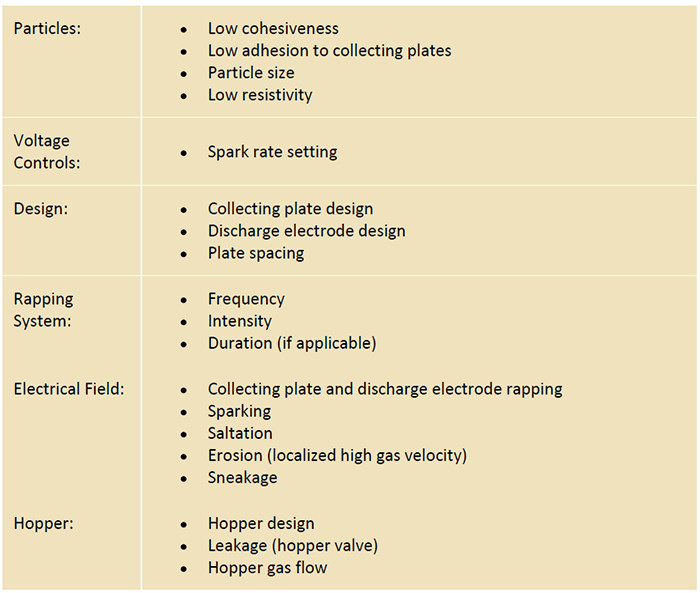Methods to Reduce ReEntrainment
Optimize Rapping
All ESP rapping systems allow for some adjustment of rapping frequency, normally starting with the highest frequency (the least time between raps), progressing to the lowest frequency. Although, variability between individual rappers or the actual frequencies that are available may be limited. For rapping systems that have pneumatic or electric actuators, variations of the rapping intensity can also be modified along with the rapping frequency. Today, state-of-the-art rapper controllers allow complete customization of the rapping sequences, including selection of individual rappers, their intensity and frequency, and also provide anti-coincidence schemes that allow only one rapper within a given lane to operate at the same time.
An optimized rapping system starts with the DE rapping system operating on its own time schedule, and having typical repeat times in the range of 2 – 4 minutes. The same is true for the gas distribution rapping system in the inlet and outlet of the precipitator, however they should be operated with repeat times of 2-3 minutes for the inlet and 2 – 3 hours for the outlet screens. Because the goal for DE and Gas distribution rapping systems are to make sure that these components stay as clean as possible, these systems require the least amount of effort for optimization.
The only rapping system that truly requires optimization is the CE rapping system, with precipitator power input and stack opacity being excellent criteria for adjustment. Typically, CE rapping optimization should start with the Collecting Plate Rapping Schedule determined above, followed by the rapping frequency of the inlet field increased or decreased until the electrical power input of the inlet field remains constant. Once the inlet field is satisfactory, the rapping frequency of the other fields should be adjusted in sequence until their electrical power inputs also remain fairly constant. If during this process the stack opacity trace shows spikes that correspond with rapping events, the rapping intensity should be reduced while simultaneously observing the electrical power input of the precipitator.
Adjustment of the rapping system for optimum precipitator performance is a methodical process, and is often considered more of an art than a science. Doing it correctly is a slow process that requires a substantial amount of time for stabilization after each adjustment.
Improve Hopper Reliability
Often times the hoppers and hopper evacuation system are overlooked as crucial elements to overall system performance. However, when hopper systems fail it can be the source of several issues that can lead to excessive sparking or performance killing re-entrainment. As hopper levels get too high, the PM within gets closer to the discharge electrodes and the flue gas moving through the precipitator. This can cause sparking between the DE and PM in the hopper, or allow the ash to be picked up by the faster moving air and carried below the CEs out of the hopper. This type of re-entrainment is cause sneakage because the PM sneaks below the collecting area and out of the ESP.
Improve Resistivity
Resistivity is dependent on temperature, particle size, and flue gas chemistry. As a result, the process can be modified to change the resistivity of PM. Typically PM resistivity involves both surface and volume resistivity. Larger particles capture charged gases easier and therefore have a lower resistivity. Smaller particles are less probable to capture charged gases and have a higher resistivity. The effect of temperature can be see in the graph below, and may be modified by improving boiler and air-preheater efficiency. As gas temperature increases, surface conductivity decreases and volume resistivity increases. In lower gas temperature ranges, volume surface conductivity predominates. The current passing through the precipitated PM layer is conducted in a film of weak sulfuric acid on the surface of the particles. Formation of the acid film (from SO3 and H2O) is influenced by the surface chemistry of the particles. In higher gas temperature ranges, volume conductivity predominates. Current conduction through the bodies (volume) of the precipitated PM is governed by the total chemistry of the particles. The third influence of resistivity, flue gas chemistry, can be modified through Implementation of flue gas conditioning systems that inject either sulfur trioxide (SO3), ammonia (NH3), or water (H2O).
Reduce Unburned Carbon (Loss on Ignition)
Electrostatic precipitators (ESPs) don’t do a very good job of collecting carbon; these particles re-entrain easily because their resistivity levels are low. ESP performance starts to noticeably degrade, and stack opacity levels to rise, when the ash contains more than 10 percent unburned carbon. High carbon concentration can also cause increased sparking and reduce secondary voltage levels in the ESP.
At most plants, carbon content in ash is measured regularly. If not, it is a relatively easy matter to send ash samples from the ESP hoppers to a lab (such as Neundorfer’s) for analysis.
When coal is not pulverized properly, and/or there is poor combustion air distribution, the result is incomplete combustion and unburned carbon. Reducing unburned carbon means you are wringing more power out of the same amount of fuel. Optimizing your combustion system isn’t just about cutting emissions; it might also reduce fuel costs.
Helpful Resources
KnowledgeBase: Optimize Corona Power
KnowledgeBase: Improve Rapping System
KnowledgeBase: Theory of Operations
Our Capabilities: Analytical & Lab Services
Our Capabilities: Equipment Assessment & Inspections




